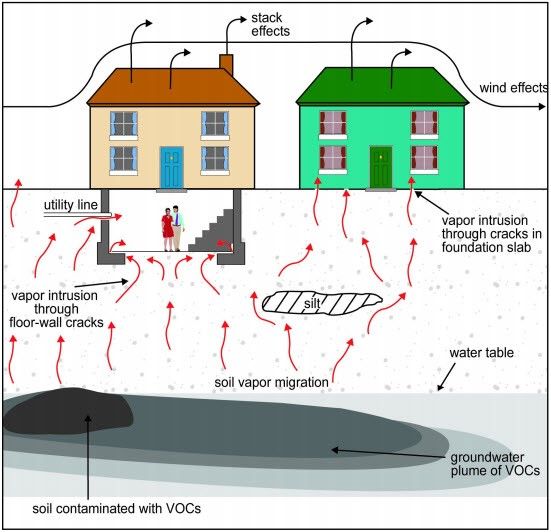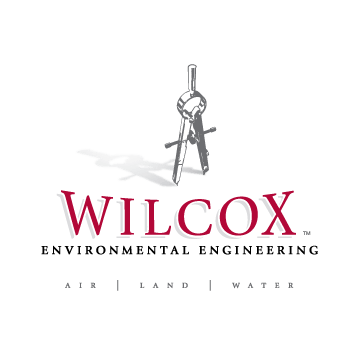There have been substantial advancements in the science of human health risk assessment utilized by environmental consulting in the past decade. Historically, the primary exposure pathway utilized in risk assessment has focused on soil and ground water media and the toxicological effects on humans and our environment. Increased regulations and development of technology have reduced the frequency of both soil and groundwater contamination as compared to 30+ years ago. While there is still a problem with soil and groundwater affecting humans, the primary way most people are affected is through the air vapor intrusion (VI).

Image 1- The diagram generalizes how subsurface vapors may impact indoor air
Vapor intrusion is defined as a “migration of volatile organic chemicals (VOC) from soil or ground water contamination into an overlying building”. Unlike soil and groundwater contamination which is typically visible with the eye or has an odor, VI is often invisible and does not have an easily recognizable smell. The rate of VI is always changing and can be impacted by some of the following elements: local weather, heating and cooling seasons, age and slab or basement construction, extent of subsurface impacts and water table depth. Oftentimes people residing or working in the building do not know the air they are breathing maybe contaminated. Vapor intrusion can occur from a wide variety of industrial facilities. The most common locations with VI concerns are gas stations, dry cleaners, and many industrial manufacturing processing, but it can extend into offsite locations as well. Many times the impacts from these facilities are not discovered until long after the spill of the chemical occurred.
The Indiana Department of Environmental Management has developed action levels in groundwater where the risk of vapor intrusion is likely to occur and therefore the pathways and structures affected need to be studied further. Vapor intrusion can have both acute and chronic health effects on the people exposed to it as well as cause safety concerns such as explosions. To combat this problem the state and federal government, as well as the environmental consulting industry, has been making strides in the science of VI. A summary of the recent development in VI was prepared by the United States Environmental Protection Agency (US EPA) Office of Solid Waste and Emergency Response in a technical document dated June 2015 Assessing and Mitigating the Vapor Intrusion Pathway from Subsurface Vapor Sources to Indoor Air (https://www.epa.gov/sites/production/files/2015-09/documents/oswer-vapor-intrusion-technical-guide-final.pdf). We are now better equipped in the investigation and remedial activities associated with VI.
An effective VI study needs to be able to distinguish between contaminants that may be coming from inside the home or office and actual vapor that have entered the structure from an underground contaminated source. To accomplish this, a pre-sampling inspection is conducted to assess any background conditions that could negatively impact the results. A few examples of the common every day conditions that can impact the results are cigarette smoke, new carpet, cleaning chemicals, and dry cleaned garments. Once these sources are identified and removed, if necessary, air samples are then collected from different locations throughout the building and below the foundation. These samples are analyzed by qualified lab technicians using EPA approved methods and the results are reported to the consultant.
Unlike soil or groundwater media which is relatively easily collected and transported to a laboratory for analysis, the collection of air samples is more difficult. For years the assessment of VOC has been completing via a method called Toxic Organics (TO) TO-15. TO-15 is a list of 97 VOC compounds that US EPA developed in the 1990s. The TO-15 method utilized a laboratory supplied stainless steel summa canister which is under vacuum to collect and transport an air sample for laboratory analysis. While the use of TO-15 is very common the practical management and sampling logistics at large sites can be challenging and costly. In recent years Wilcox, has been using method TO-17 as an alternative to TO-15. Unlike TO-15 where a whole air sample is collected, TO-17 utilizes sorption in the field to extract the chemical of concern from the air into a laboratory supplied tube that is submitted for analysis following a desorption process. Both methods utilizes a gas chromatography-mass spectrometry during the sample analysis at the laboratory, however, TO-17 is easier to use in the field due to its size and can be utilized to report an expanded range of compounds beyond just VOCs.
Vapor intrusion is a common but easily solvable problem. There have been many advances in the technology allowing environmental consultants to properly identify the chemicals causing the air contamination and therefore eliminate them. While every site is unique and challenging in its own way Wilcox Environmental Engineering is ready and willing to help you solve your VI problems.
